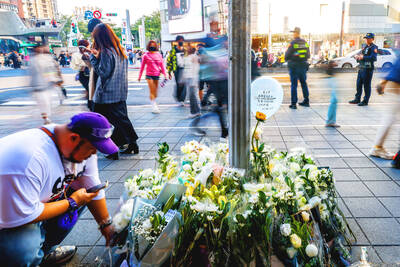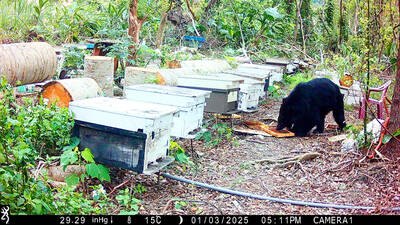The Ministry of Education’s “China-centric” adjustments to high-school curriculum guidelines seek to undermine Aboriginal history and culture, Presbyterian pastor Omi Wilang said.
Omi, an Atayal, said that Aborigines are the most qualified to address Taiwanese history, and the Chinese Nationalist Party’s (KMT) “government-in-exile” — which retreated to Taiwan from China after it lost the Chinese Civil War — is trying to reconnect with its Chinese roots at a time when Aboriginal peoples are seeking to re-establish their cultural traditions.
Taiwanese Aborigines have nothing to do with the Yangtze River and Yellow River in China, Omi said, questioning the ministry’s objective in educating Aboriginal students about Chinese and unificationist ideology.
The new guidelines are tantamount to Sinicization and aims to eliminate and assimilate Aboriginal students, which is an act of state violence, he said, adding that he was thankful to students participating in an anti-curriculum campaign.
Different Aboriginal peoples — be they Bunun, Atayal or Sediq — have different histories, cultures and customs, he said.
However, the ministry is using the state’s power to infiltrate the history and lives of Aborigines with its unificationist agenda, preventing Aboriginal students from living up to their ancestors’ legacies, he said.
Many Aboriginal peoples have lost their roots because of state violence: They know about the Yangtze River, Yellow River and Amur River in China, but do not know what the different mountains in Taiwan means to different Aboriginal communities — such as Dawu Mountain (大武山), which is sacred to the Paiwan, Yushan (玉山) to the Bunun and Dabajian Mountain (大霸尖山) to the Atayal, he said.
Those sacred mountains are where Aborigines have shaped their cultures and bred numerous generations, which should not be lost to later generations, Omi Wilang said.
Those who are educated in the new curriculum would become unrecognizable to their ancestral spirits and would be unable to cross the rainbow bridge to the hereafter, he said.
The pastor was referring to the Atayal belief that the souls of the deceased have to pass the rainbow bridge to where the spirits of their ancestors dwell, and those who do not have facial tattoos or other distinguishing marks would not be recognized by their ancestors and would fall off the bridge, unable to get into heaven or reunite with their people.
The new curriculum seeks to replace Aboriginal culture with a China-centric ideology, which is against Aborigines’ mission to pass down their history and cultural legacy, Omi said.
All people are created equal in the eyes of God, whether they are Chinese with a population of 1.3 billion or Thao — the nation’s smallest Aboriginal group with only 716 people, he said.
The curriculum should embrace pluralism and describe truthfully the history of different peoples, he said.
The Republic of China designates Oct. 25 as Taiwan’s Retrocession Day, but the date spells ruin for Aborigines, he said, adding that different peoples should respect each other and their points of view.

SHIPS, TRAINS AND AUTOMOBILES: The ministry has announced changes to varied transportation industries taking effect soon, with a number of effects for passengers Beginning next month, the post office is canceling signature upon delivery and written inquiry services for international registered small packets in accordance with the new policy of the Universal Postal Union, the Ministry of Transportation and Communications said yesterday. The new policy does not apply to packets that are to be delivered to China, the ministry said. Senders of international registered small packets would receive a NT$10 rebate on postage if the packets are sent from Jan. 1 to March 31, it added. The ministry said that three other policies are also scheduled to take effect next month. International cruise ship operators

HORROR STORIES: One victim recounted not realizing they had been stabbed and seeing people bleeding, while another recalled breaking down in tears after fleeing A man on Friday died after he tried to fight the knife-wielding suspect who went on a stabbing spree near two of Taipei’s busiest metro stations, Taipei Mayor Chiang Wan-an (蔣萬安) said. The 57-year-old man, identified by his family name, Yu (余), encountered the suspect at Exit M7 of Taipei Main Station and immediately tried to stop him, but was fatally wounded and later died, Chiang said, calling the incident “heartbreaking.” Yu’s family would receive at least NT$5 million (US$158,584) in compensation through the Taipei Rapid Transit Corp’s (TRTC) insurance coverage, he said after convening an emergency security response meeting yesterday morning. National

PLANNED: The suspect visited the crime scene before the killings, seeking information on how to access the roof, and had extensively researched a 2014 stabbing incident The suspect in a stabbing attack that killed three people and injured 11 in Taipei on Friday had planned the assault and set fires at other locations earlier in the day, law enforcement officials said yesterday. National Police Agency (NPA) Director-General Chang Jung-hsin (張榮興) said the suspect, a 27-year-old man named Chang Wen (張文), began the attacks at 3:40pm, first setting off smoke bombs on a road, damaging cars and motorbikes. Earlier, Chang Wen set fire to a rental room where he was staying on Gongyuan Road in Zhongzheng District (中正), Chang Jung-hsin said. The suspect later threw smoke grenades near two exits

The Forestry and Nature Conservation Agency yesterday launched a gift box to market honey “certified by a Formosan black bear” in appreciation of a beekeeper’s amicable interaction with a honey-thieving bear. Beekeeper Chih Ming-chen (池明鎮) in January inspected his bee farm in Hualien County’s Jhuosi Township (卓溪) and found that more than 20 beehives had been destroyed and many hives were eaten, with bear droppings and paw prints near the destroyed hives, the agency said. Chih returned to the farm to move the remaining beehives away that evening when he encountered a Formosan black bear only 20m away, the agency said. The bear